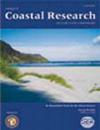海滩救援统计数据及其与近岸形态和危险的关系:英格兰西南部案例研究
4区 地球科学
Q3 Earth and Planetary Sciences
引用次数: 50
摘要
SCOTT, T., RUSSELL, P., MASSELINK, G., WOOLER, A., and SHORT, A., 2007.Beach rescue statistics and their relation to nearshore morphology and hazards: a case study for southwest England.Journal of Coastal Research, SI 50 (Proceedings of the 9th International Coastal Symposium), 1 - 6.澳大利亚黄金海岸,ISSN 0749.0208 英格兰西南部的德文郡和康沃尔郡海岸经历着英国一些最强劲的波浪条件(Hs,10% = 2-3 米)和最大的潮汐范围 MSR = (4.2-8.6 米)。这里也是夏季的热门旅游胜地,每年游客超过 1000 万人次。高能波浪/潮汐条件给海滩使用者带来了相当大的身体风险,因此该地区的 62 个海滩环境都有英国皇家救生艇协会 (RNLI) 救生员巡逻。我们对英国皇家救生艇协会在春季和夏季(5 月 1 日至 10 月 1 日)收集的海滩救援统计数据进行了分析,以研究和量化物理海滩危险给海滩使用者带来的风险。研究发现,激流是主要的危险因素,占所有记录事件的 71%。最危险的海滩位于研究区域裸露的西海岸。这里的海滩在形态动力学上可归类为中间型,其特点是低潮时的潮间带和裂流系统,在地形上通常受到潮间带地质的限制。裂流一般在落潮前后最为活跃。德文郡和康沃尔郡的海滩由于结合了高能冲浪区、大潮汐和多变的海岸地质,在形态上 与以前研究过的澳大利亚海滩有很大不同。这项工作标志着英国向标准化海滩风险评估迈出了第一步。本文章由计算机程序翻译,如有差异,请以英文原文为准。
Beach Rescue Statistics and their Relation to Nearshore Morphology and Hazards: A Case Study for Southwest England
SCOTT, T., RUSSELL, P., MASSELINK, G., WOOLER, A., and SHORT, A., 2007. Beach rescue statistics and their relation to nearshore morphology and hazards: a case study for southwest England. Journal of Coastal Research, SI 50 (Proceedings of the 9th International Coastal Symposium), 1 – 6. Gold Coast, Australia, ISSN 0749.0208 The coasts of Devon and Cornwall in the southwest of England experience some of the most energetic wave conditions (Hs,10% = 2–3 m) and largest tide ranges MSR = (4.2–8.6 m) in the UK. They are also a popular tourist destination during the summer months with over 10 million visitors per year. The energetic wave/tide conditions pose a considerable physical risk to beach users and 62 beach environments in this region are therefore patrolled by Royal National Lifeboat Institution (RNLI) lifeguards. Beach rescue statistics collected by the RNLI during spring and summer (1 May to 1 October) were analysed to examine and quantify the risk posed by physical beach hazards to beach users. Rip currents were found to be the main hazard and were responsible for 71% of all recorded incidents. The most hazardous beaches were found on the exposed west coast of the study area. Beaches here can be classified as morphodynamically intermediate and are characterized by low-tide tide bar and rip systems, often topographically-constrained by intertidal geology. The rip currents are generally most active around low tide. Beaches in Devon and Cornwall exhibit morphologies that are significantly different from previously studied beaches in Australia due to the combination of high energy surf zones, large tides and variable coastal geology. This work represents a first step towards the generation of standardized beach risk assessments in the UK.
求助全文
通过发布文献求助,成功后即可免费获取论文全文。
去求助
来源期刊

Journal of Coastal Research
地学-地球科学综合
自引率
0.00%
发文量
87
审稿时长
3-8 weeks
期刊介绍:
The Journal of Coastal Research (JCR) is one of the leading international journals for coastal studies and processes, and is published bi-monthly by the Coastal Education & Research Foundation [CERF]. By covering the entire field of coastal research, the JCR encompasses all subjects relevant to natural and engineered environments (freshwater, brackish, or marine) and the protection/management of their resources in the vicinity of coastlines of the world. Even though the journal broadly focuses on immediate shoreline zones, the JCR also embraces those coastal environments that either reach some indefinite distance inland or that extend seaward beyond the outer margins of the sublittoral (neritic) zone. The JCR disseminates accurate information to both the public and research specialists around the world on all aspects of coastal issues in an effort to maintain or improve the quality of our planet''s shoreline resources.
 求助内容:
求助内容: 应助结果提醒方式:
应助结果提醒方式:


